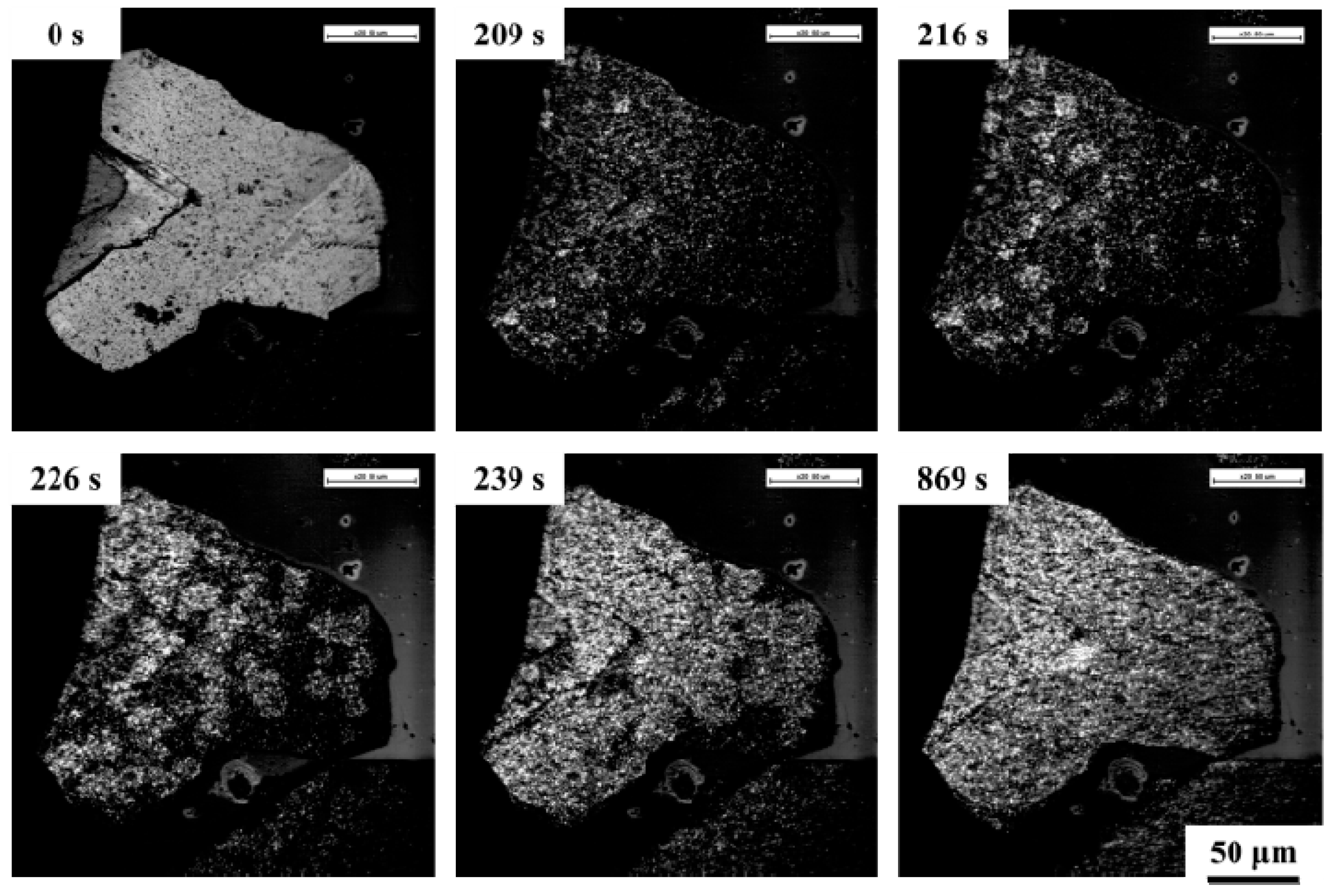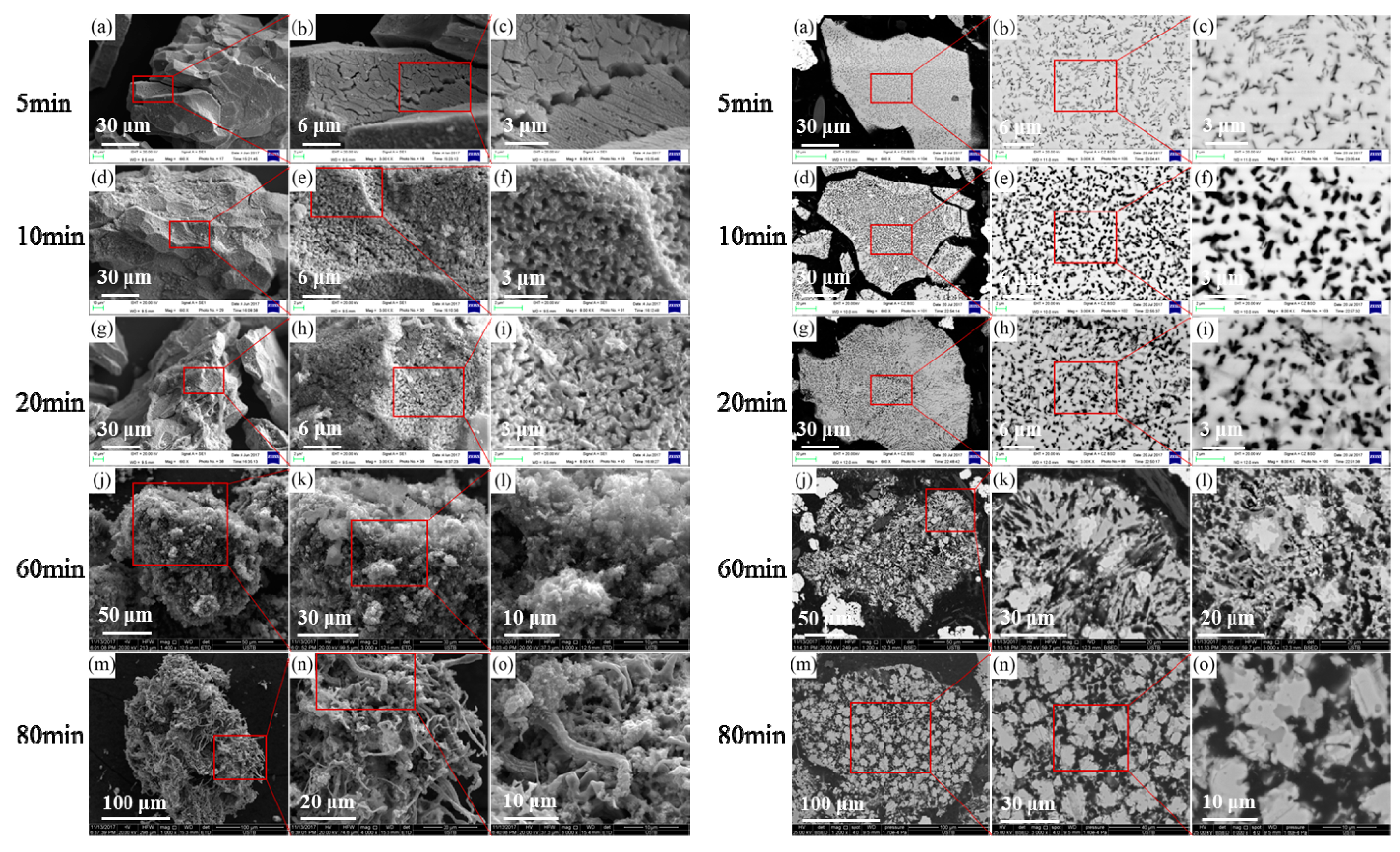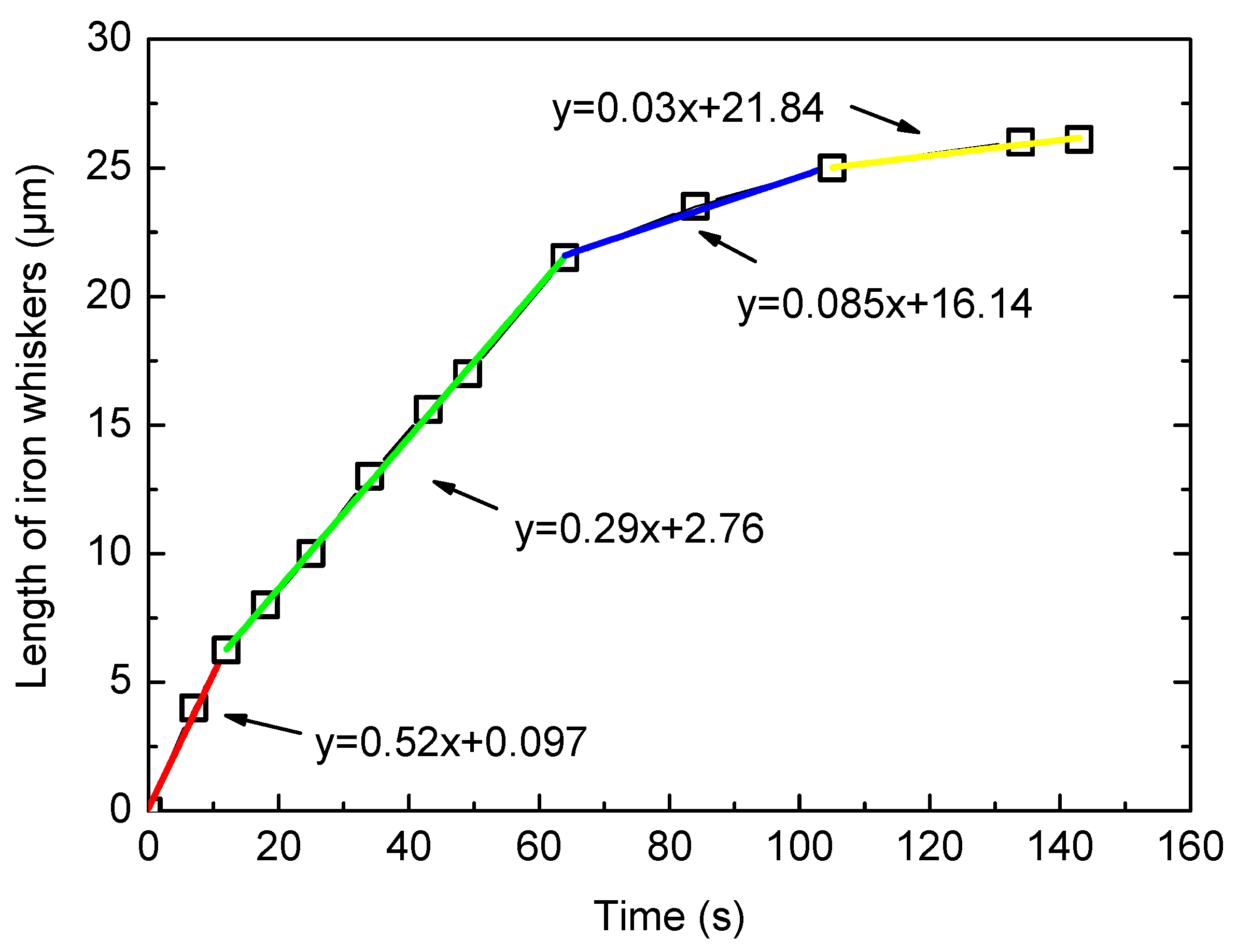Nucleation and Growth of Iron Whiskers during Gaseous Reduction of Hematite Iron Ore Fines
Abstract
1. Introduction
2. Experimental
2.1. Material
2.2. In-Situ Online Observation of the Reducing Process of Iron Ore Particles
2.3. Online Quenching and Offline Characterization
3. Results and Discussion
3.1. The In-Situ Online Observation
3.1.1. The “Blooming” Phenomenon on the Surface of Particles
3.1.2. The Growth of Iron Whiskers
3.1.3. Influence of Temperature, Atmosphere, and Other Factors
3.2. The Online Quenching Experiments
3.2.1. Evolution of Surface Morphology
3.2.2. Evolution of Cross-Section Morphology
3.3. Crystallization Characteristics of Iron Whiskers
4. Discussions
4.1. Reduction Mechanism of the Hematite Iron Ore Fines
4.2. Diffusion and Nucleation of Iron Atoms during Reduction
4.3. The Generating Mechanism of Layered Iron and Iron Whiskers
4.4. External Influence Factors of Iron Whiskers
4.5. The Reduction Process of a Single Iron Ore Particle
5. Conclusions
Author Contributions
Funding
Conflicts of Interest
References
- Schenk, J.L. Recent Status of Fluidized Bed Technologies for Producing Iron Input Materials for Steelmaking. Particuology 2011, 9, 14–23. [Google Scholar] [CrossRef]
- Yuan, Z.; Sohn, H.Y. Re-Oxidation Kinetics of Flash Reduced Iron Particles in O2-N2 Gas Mixtures Relevant to a Novel Flash Ironmaking Process. ISIJ Int. 2014, 54, 1235–1243. [Google Scholar] [CrossRef]
- Xing, L.Y.; Zou, Z.S.; Qu, Y.X.; Lei, S. Gas-Solid Reduction Behavior of In-Flight Fine Hematite Ore Particles by Hydrogen. Steel Res. Int. 2019, 90, 1800311. [Google Scholar] [CrossRef]
- Sabat, K.C.; Murphy, A.B. Hydrogen Plasma Processing of Iron Ore. Metall. Mater. Trans. B 2017, 48, 1561–1594. [Google Scholar] [CrossRef]
- Davis, M.P.; Dry, R.J.; Schwarz, M.P. The Role of CFD Modeling in Development of the HIsmelt Process. In Proceedings of the ISS Tech Conference, Indianapolis, IN, USA, 27–30 April 2003; pp. 201–214. [Google Scholar]
- Sripriya, R.; Peeters, T.; Meijer, K.; Zeilstra, C.; Van der Plas, D. Computational Fluid Dynamics and Combustion Modelling of HIsarna Incinerator. Ironmak. Steelmak. 2016, 43, 192–202. [Google Scholar] [CrossRef]
- Chen, F.; Mohassab, Y.; Jiang, T.; Sohn, H.Y. Hydrogen Reduction Kinetics of Hematite Concentrate Particles Relevant to a Novel Flash Ironmaking Process. Metall. Mater. Trans. B 2015, 46, 1133–1145. [Google Scholar] [CrossRef]
- Thaler, C.; Tappeiner, T.; Schenk, J.L.; Kepplinger, W.L.; Plaul, J.F.; Schuster, S. Integration of the Blast Furnace Route and the FINEX®-Process for Low CO2 Hot Metal Production. Steel Res. Int. 2012, 83, 181–188. [Google Scholar] [CrossRef]
- Hillisch, W.; Zirngast, J. Status of Finmet Plant Operation at BHP DRI. J. Steel Times Int. 2001, 98, 231–237. [Google Scholar] [CrossRef]
- Sarkar, R.; Sohn, H.Y. Interactions of Alumina-based and Magnesia-based Refractories with Iron Melts and Slags: A Review. Metall. Mater. Trans. B 2018, 49, 1860–1882. [Google Scholar] [CrossRef]
- Guo, L.; Yang, Z.R.; Gao, J.T.; Zhong, Y.W.; Guo, Z.C. Effect of Coating Mg(OH)2 with Heterogeneous Deposition Method on Sticking During Fluidized Bed Reduction of Iron Ore. ISIJ Int. 2016, 56, 736–743. [Google Scholar] [CrossRef]
- Zhang, P.G.; Zhang, Y.M.; Sun, Z.M. Spontaneous Growth of Metal Whiskers on Surfaces of Solids: A Review. J. Mater. Sci. Technol. 2015, 31, 675–698. [Google Scholar] [CrossRef]
- Brenner, S.S.; Sears, G.W. Mechanism of Whisker Growth—III Nature of Growth Sites. Acta Metall. 1956, 4, 268–270. [Google Scholar] [CrossRef]
- Wang, H.T.; Sohn, H.Y. Effects of Reducing Gas on Swelling and Iron Whisker Formation during the Reduction of Iron Oxide Compact. Steel Res. Int. 2012, 83, 903–909. [Google Scholar] [CrossRef]
- Iguchi, Y.; Uyeda, Y.; Goto, K.; Hayashi, S. In Situ Observation of Nucleation and Growth of Iron Whiskers from Supersaturated Wustite. Oxid. Met. 1994, 42, 103–108. [Google Scholar] [CrossRef]
- Sciti, D.; Pienti, L.; Fabbriche, D.D.; Guicciardi, S.; Silvestroni, L. Combined Effect of SiC Chopped Fibers and SiC Whiskers on the Toughening of ZrB2. Ceram. Int. 2014, 40, 4819–4826. [Google Scholar] [CrossRef]
- Mashhadi, M.; Mearaji, F.; Tamizifar, M. The Effects of NH4Cl Addition and Particle size of Al Powder in AlN Whiskers Synthesis by Direct Nitridation. Int. J. Refract. Met. Hard Mater. 2014, 46, 181–187. [Google Scholar] [CrossRef]
- Chen, S.H.; Zhang, D.F.; Li, J.Q.; Sun, G. In-situ Formation of MGO Whiskers on the Surface of Magnesium Alloy Powders. Powder Technol. 2014, 253, 677–680. [Google Scholar] [CrossRef]
- Yan, P.K.; Ma, Z.X.; Gao, Y.J. Overview of Progress in Magnesium Carbonate Wiskers. China Non-Met. Miner. Ind. 2009, 23, 23–25. [Google Scholar]
- Cao, M.L.; Zhang, C.; Lv, H.F.; Xu, L. Characterization of Mechanical Behavior and Mechanism of Calcium Carbonate Whisker-reinforced Cement Mortar. Constr. Build. Mater. 2014, 66, 89–97. [Google Scholar] [CrossRef]
- El-Geassy, A.A.; Nasr, M.I.; Hessien, M.M. Effect of Reducing Gas on the Volume Change During Reduction of Iron Oxide Compacts. ISIJ Int. 1996, 36, 640–649. [Google Scholar] [CrossRef]
- John, D.S.; Matthew, S.P.; Hayes, P.C. The Breakdown of Dense Iron Layers on Wustite in CO/CO2 and H2/H2O Systems. Metall. Mater. Trans. B 1984, 15, 701–708. [Google Scholar] [CrossRef]
- Nicolle, R.; Rist, A. The Mechanism of Whisker Growth in the Reduction of Wustite. Metall. Mater. Trans. B 1979, 10, 429–438. [Google Scholar] [CrossRef]
- Kohl, H.K.; Engell, H.J. Uber Die Reduktion Von Wustit Mit Wasserstoff. Archiv für das Eisenhüttenwesen 1963, 34, 411–418. [Google Scholar] [CrossRef]
- Toru, Y.; Tomoya, N.; Kazuhiro, N.; Kazuhiro, N. In-Situ Observation of Fe0.94O Reduction at High Temperature with the use Optical Microscopy. Metall. Mater. Trans. B 2007, 38, 185–191. [Google Scholar] [CrossRef]
- Guo, L.; Gao, J.T.; Zhong, S.P.; Bao, Q.P.; Guo, Z.C. In Situ Observation of Iron Ore Particle Reduction Above 1373 K by Confocal Microscopy. J. Iron Steel Res. Int. 2019, 26, 32–41. [Google Scholar] [CrossRef]
- Bahgat, M.; Sasaki, Y.; Iguchi, M.; Ishii, K. The Effect of Grain Boundaries on the Surface Rearrangement During Wustite Reduction Within its Range of Existence. ISIJ Int. 2005, 45, 657–661. [Google Scholar] [CrossRef]
- John, D.S.; Matthew, S.P.; Hayes, P.C. Establishment of Product Morphology during the Initial Stages of Wustite Reduction. Metall. Mater. Trans. B 1984, 15, 709–717. [Google Scholar] [CrossRef]
- Bahgat, M.; Sasaki, Y.; Hijino, S.; Iguchi, M.; Ishiiet, K. The Effect of Grain Boundaries on Iron Nucleation During Wustite Reduction Process. ISIJ Int. 2004, 44, 2023–2028. [Google Scholar] [CrossRef]
- Wagner, C. Fundamental Consideration of the Reduction of Oxides and Sulfides. In Physical Chemistry of Steelmaking; The MIT Press: Cambridge, MA, USA, 1962; pp. 19–26. [Google Scholar]
- Roine, A. HSC 5.1 Chemical Recation and Equilibrium Software with Extensive Thermochemical Database; Outokumpu: Helsinki, Finland, 2002. [Google Scholar]
- Sasaki, Y.; Bahgat, M.; Iguchi, M.; Ishii, K. The Preferable Growth Direction of Iron Nuclei on Wustite Surface during Reduction. ISIJ Int. 2005, 45, 1077–1083. [Google Scholar] [CrossRef][Green Version]
- Yun, Z.Z. Surface and Interface Physics; University of Electronic Science and Technology Press: Chengdu, China, 1993; p. 190. [Google Scholar]
- Halim, K.; Bahgat, M.; El-Kelesh, H.A.; Masret, M.I. Metallic Iron Whisker Formation and Growth during Iron Oxide Reduction: Basicity effect. Ironmak. Steelmak. 2009, 36, 631–640. [Google Scholar] [CrossRef]
- Kasabgy, T.E.; Lu, W.K. The Influence of Calcia and Magnesia in Wustite on the Kinetics of Metallization and Iron Whisker Formation. Metall. Mater. Trans. B 1980, 11, 409–414. [Google Scholar] [CrossRef]
- Iguchi, Y.; Goto, K.; Hayashi, S. Surface Segregation of Calcium Oxide in Wustite and its Effects on the Reduction. Metall. Mater. Trans. B 1994, 25, 405–413. [Google Scholar] [CrossRef]
- Gransden, J.F.; Sheasbu, J.S. The Sticking of Iron Ore during Reduction by Hydrogen in a Fluidized Bed. Can. Metall. Q. 1974, 13, 649–657. [Google Scholar] [CrossRef]
- Zhao, Z.L.; Tang, H.Q.; Guo, Z.C. In Situ Observation and Mechanism Research of the Influence of CaO on the Growth of Iron Whiskers under CO Atmosphere. J. Univ. Sci. Technol. Beijing 2011, 33, 817–822. [Google Scholar] [CrossRef]
- Han, F.L. Reduced Iron Powder from Mill Scale. Powder Metall. Technol. 2001, 19, 33–44. [Google Scholar] [CrossRef]















| Component | TFe | Fe2O3 | FeO | SiO2 | CaO | MgO | Al2O3 |
|---|---|---|---|---|---|---|---|
| Content | 68.08 | Bal. | 0.21 | 2.26 | 0.046 | 0.11 | 0.32 |
| No. | Temperature/K | Reduction Time/min | Reducing Atmosphere | Gas Flow/(ml/min) |
|---|---|---|---|---|
| 1 | 973 | 5 | 95% CO + 5% CO2 | 500 |
| 2 | 1073 | 5 | 95% CO + 5% CO2 | 500 |
| 3 | 1173 | 5 | 95% CO + 5% CO2 | 500 |
| 4 | 973 | 10 | 95% CO + 5%CO2 | 500 |
| 5 | 1073 | 10 | 95% CO + 5% CO2 | 500 |
| 6 | 1173 | 10 | 95% CO + 5% CO2 | 500 |
| 7 | 973 | 20 | 95% CO + 5% CO2 | 500 |
| 8 | 1073 | 20 | 95% CO + 5% CO2 | 500 |
| 9 | 1173 | 20 | 95% CO + 5% CO2 | 500 |
| 10 | 973 | 60 | 95% CO + 5% CO2 | 500 |
| 11 | 1073 | 60 | 95% CO + 5% CO2 | 500 |
| 12 | 1173 | 60 | 95% CO + 5% CO2 | 500 |
| 13 | 973 | 80 | 95% CO + 5% CO2 | 500 |
| 14 | 1073 | 80 | 95% CO + 5% CO2 | 500 |
| 15 | 1173 | 80 | 95% CO + 5% CO2 | 500 |
© 2019 by the authors. Licensee MDPI, Basel, Switzerland. This article is an open access article distributed under the terms and conditions of the Creative Commons Attribution (CC BY) license (http://creativecommons.org/licenses/by/4.0/).
Share and Cite
Guo, L.; Zhong, S.; Bao, Q.; Gao, J.; Guo, Z. Nucleation and Growth of Iron Whiskers during Gaseous Reduction of Hematite Iron Ore Fines. Metals 2019, 9, 750. https://doi.org/10.3390/met9070750
Guo L, Zhong S, Bao Q, Gao J, Guo Z. Nucleation and Growth of Iron Whiskers during Gaseous Reduction of Hematite Iron Ore Fines. Metals. 2019; 9(7):750. https://doi.org/10.3390/met9070750
Chicago/Turabian StyleGuo, Lei, Shengping Zhong, Qipeng Bao, Jintao Gao, and Zhancheng Guo. 2019. "Nucleation and Growth of Iron Whiskers during Gaseous Reduction of Hematite Iron Ore Fines" Metals 9, no. 7: 750. https://doi.org/10.3390/met9070750
APA StyleGuo, L., Zhong, S., Bao, Q., Gao, J., & Guo, Z. (2019). Nucleation and Growth of Iron Whiskers during Gaseous Reduction of Hematite Iron Ore Fines. Metals, 9(7), 750. https://doi.org/10.3390/met9070750





